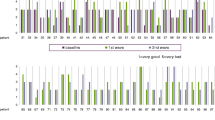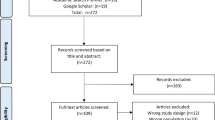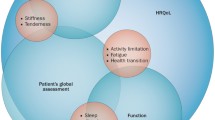Summary
This review examines the current use of health status instruments, such as questionnaires, in randomised clinical trials in rheumatoid arthritis (RA). A computer-assisted literature search was done using information from January 1996 until May 1997. The articles included were reviewed in a standardised way according to the kind of study-design, type of intervention, treatment arms, study population, follow-up, use of outcome measures, use of the core set and of the response criteria, and the results.
44 trials were identified and, of these, 31 were included. Of the 31 efficacy studies on RA patients, 10 did not use health status instruments. The most frequently used health status instruments were the Arthritis Impact Measurement Scales (AIMS) and the Stanford Health Assessment Questionnaire (HAQ). Of 21 studies, 5 showed a between-group difference with respect to health status.
The main finding was that health status instruments are inconsistently used and lack full description and standardisation in their use as end-points in randomised clinical trials in RA.
Similar content being viewed by others
References
Kirwan JR. A theoretical framework for process, outcome and prognosis in rheumatoid arthritis. J Rheumatol 1992; 19 (3): 333–6.
Cheah SY, Clark C, Goldberg L, et al. Outcome measures, pooled index and quality of life instruments in rheumatoid arthritis. J Clin Pharm Ther 1996; 21: 297–316.
Fries JF, Spitz P, Kraines RG, et al. Measurement of patient outcome in arthritis. Arthritis Rheum 1980; 23 (2): 137–45.
Fitzpatrick R, Ziebland S, Jenkinson C, et al. A generic health status instrument in the assessment of rheumatoid arthritis. Br J Rheumatol 1992; 31: 87–90.
Torrance GW. Measurement of health state utilities for economic appraisal: a review. J Health Econ 1986; 5: 1–30.
Current world literature. Curr Opin Rheumatol 1997; 9 (3): B67–126.
Boers M, Tugwell P, Brooks PM. Progress towards optimal trail end-points in rheumatoid arthritis. Biodrugs 1997; 7 (1): 40–50.
Maisiak R, Austin J, Heck L. Health outcomes of two telephone interventions for patients with rheumatoid arthritis or osteo-arthritis. Arthritis Rheum 1996; 39 (8): 1391–9.
Anderson JJ, O’Neill A, Woodworth T, et al. Health status response of rheumatoid arthritis to treatment with D AB486IL-2. Arthritis Care Res 1996; 9 (2): 112–9.
Prupas M, Loose LD, Spindler JS, et al. Tenidap in patients with rheumatoid arthritis: a 4 week, placebo-controlled study. Scand J Rheumatol 1996; 25: 345–51.
Ten Wolde S, Breedveld FC, Hermans J, et al. Randomised placebo-controlled study of stopping second-line drugs in rheumatoid arthritis. Lancet 1996; 347: 347–52.
Lemmel EM, Bolten W, Burgos-Vargas R, et al. Efficacy and safety of meloxicam in patients with rheumatoid arthritis. J Rheumatol 1997; 24: 282–90.
Maggs FM, Jubb RW, Kemm JR. Single blind randomized controlled trail of an educational booklet for patients with chronic arthritis. Br J Rheumatol 1996, 35: 775–7.
Maisiak R, Austin JS, West SG, et al. The effect of person-centered counseling on the psychological status of persons with systemic lupus erythematosus or rheumatoid arthritis: a randomised, controlled trial. Arthritis Care Res 1996; 9 (1): 60–6.
Rall LC, Meydani SN, Kehayias JJ, et al. The effect of progressive resistance training in rheumatoid arthritis: increased strength without changes in energy balance or body composition. Arthritis Rheum 1996; 39 (3): 415–26.
Van den Ende C, Hazes J, le Cessie S, et al. Comparison of high and low intensity training in well controlled rheumatoid arthritis. Results of a randomised clinical trail. Ann Rheum Dis 1996; 55: 798–805.
Drevlow BE, Lovis R, Haag MA, et al. Recombinant human interleukin-1 receptor type I in the treatment of patients with active rheumatoid arthritis. Arthritis Rheum 1996; 39 (2): 257–65.
Olsen NJ, Brooks RH, Cush JJ, et al. A double blind placebo controlled study of anti-cd5 immunoconjugate in patients with rheumatoid arthritis. Arthritis Rheum 1996; 39 (7): 1102–8.
Sieper J, Kary S, Sauorensen H, et al. Oral type TJ collagen treatment in early rheumatoid arthritis: a double-blind, placebo-controlled, randomized trial. Arthritis Rheum 1996; 39 (1): 41–51.
Bendix G, Bjelle A. Adding low-dose cyclosporin A to parenteral gold therapy in rheumatoid arthritis: a double blind placebo controlled study. Br J Rheumatol 1996; 35: 1142–9.
Eberhardt K, Rydgren L, Fex E. D-penicillamine in early rheumatoid arthritis: experience from a 2-year double blind placebo controlled study. Clin Exp Rheumatol 1996; 14: 625–31.
Götzsche PC, Hansen M, Stoltenberg M, et al. Randomized, placebo controlled trial of withdrawal of slow-acting anti-rheumatic drugs and of observer bias in rheumatoid arthritis. Scand J Rheumatol 1996; 25: 194–9.
Pasero G, Priolo F, Marubini E, et al. Slow progression of joint damage in early rheumatoid arthritis treated with cyclosporin A. Arthritis Rheum 1996; 39 (6): 1006–15.
Rau R, Herborn G, Menninger H. Comparison of intramuscular methotrexate and gold sodium thiomalate in the treatment of early erosive rheumatoid arthritis: 12 month data of a double-blind parallel study of 174 patients. Br J Rheumatol 1997; 36: 345–52.
Van den Borne BE, Landewé RB, Goei HS. Low dose cyclosporine in early rheumatoid arthritis: effective and safe after two years of therapy when compared with chloroquine. Scand J Rheumatol 1996; 25: 307–16.
Wojtulewski JA, Schattenkirchner M, Barcelaao P, et al. A six-month double-blind trial to compare the efficacy and safety of meloxicam 7.5 mg daily and naproxen 750 mg daily in patients with rheumatoid arthritis. Br J Rheumatol 1996; 35 Suppl. 1: 22–8.
Stenström C, Arge B, Sundbom A. Home exercise and compliance in inflammatory rheumatic diseases, a prospective clinical trail. J Rheumatol 1997; 24: 470–6.
Vliet Vlieland TPM, Zwinderman AH, Vandenbroucke JR A randomized clinical trial of in-patient multidisciplinary treatment versus routine out-patient care in active rheumatoid arthritis. Br J Rheumatol 1996; 35: 475–82.
Vliet Vlieland TPM, Breedveld FC, Hazes JMW. The two-year follow-up of a randomized comparison of in-patient multidisciplinary team care and routine out-patient care for active rheumatoid arthritis. Br J Rheumatol 1997; 36: 82–5.
Meenan RF, Gertman PM, Mason JH, et al. Measuring health status in arthritis, the arthritis impact measurement scales. Arthritis Rheum 1980; 23: 146–50.
Meenan RF, Mason JH, Anderson JJ, et al. ATMS2: the content and properties of a revised and expanded AIMS health status questionnaire. Arthritis Rheum 1992; 35: 1–10.
Testa M, Anderson RB, Nackley, JF. Quality of life and antihy-pertensive therapy in men: a comparison of captopril with enalapril. Quality of Life Hypertension Study Group. N Engl J Med 1993; 328: 907–13.
Author information
Authors and Affiliations
Corresponding author
Additional information
About the Authors: Gerold Stucki is an Associate Professor of Rheumatology and head of the institute for Physical Medicine at the University Hospital in Zurich.
Jaap Fransen, MSc, is a Research Fellow at the Institute of Physical Medicine at the University Hospital in Zurich.
Rights and permissions
About this article
Cite this article
Fransen, J., Stucki, G. Current Use of Health Status Instruments in Randomised Controlled Trials on Patients with Rheumatoid Arthritis. Dis-Manage-Health-Outcomes 3, 271–277 (1998). https://doi.org/10.2165/00115677-199803060-00002
Published:
Issue Date:
DOI: https://doi.org/10.2165/00115677-199803060-00002




